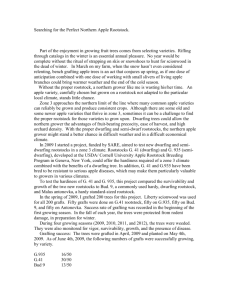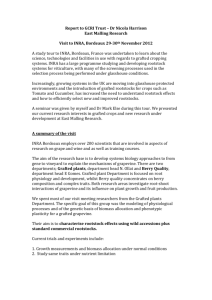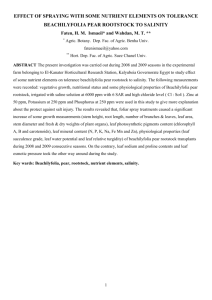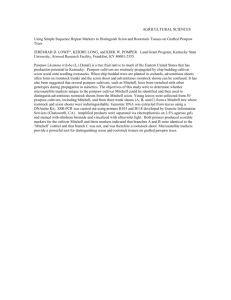Book 1 Chapter 4 Avocado Rootstocks
advertisement
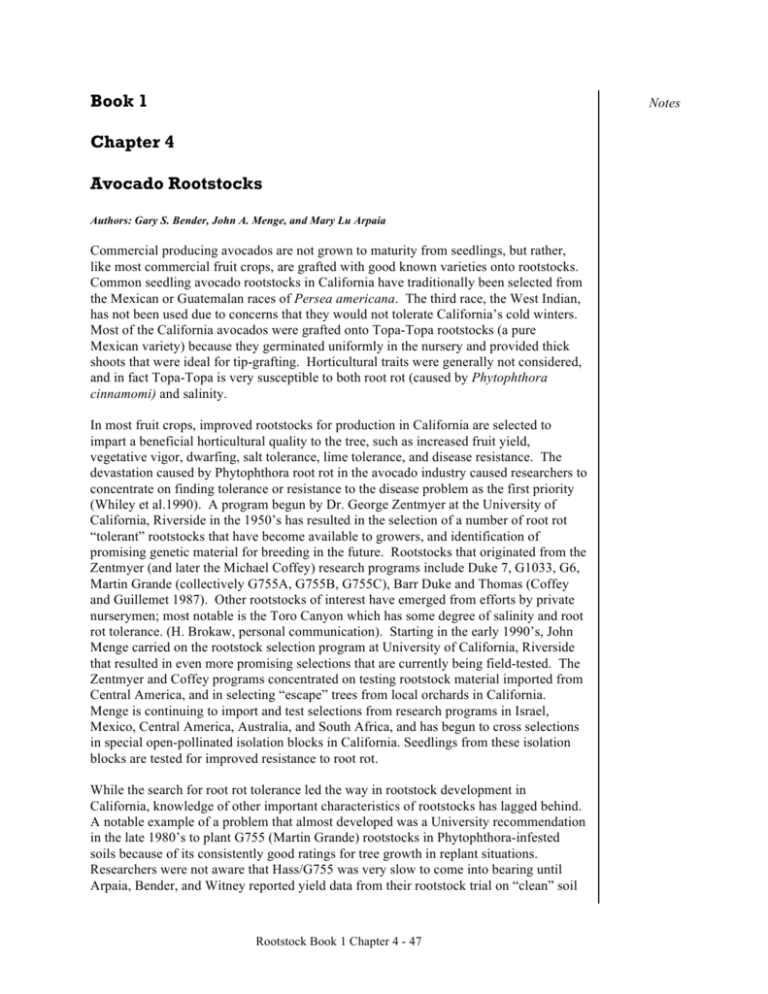
Book 1 Notes Chapter 4 Avocado Rootstocks Authors: Gary S. Bender, John A. Menge, and Mary Lu Arpaia Commercial producing avocados are not grown to maturity from seedlings, but rather, like most commercial fruit crops, are grafted with good known varieties onto rootstocks. Common seedling avocado rootstocks in California have traditionally been selected from the Mexican or Guatemalan races of Persea americana. The third race, the West Indian, has not been used due to concerns that they would not tolerate California’s cold winters. Most of the California avocados were grafted onto Topa-Topa rootstocks (a pure Mexican variety) because they germinated uniformly in the nursery and provided thick shoots that were ideal for tip-grafting. Horticultural traits were generally not considered, and in fact Topa-Topa is very susceptible to both root rot (caused by Phytophthora cinnamomi) and salinity. In most fruit crops, improved rootstocks for production in California are selected to impart a beneficial horticultural quality to the tree, such as increased fruit yield, vegetative vigor, dwarfing, salt tolerance, lime tolerance, and disease resistance. The devastation caused by Phytophthora root rot in the avocado industry caused researchers to concentrate on finding tolerance or resistance to the disease problem as the first priority (Whiley et al.1990). A program begun by Dr. George Zentmyer at the University of California, Riverside in the 1950’s has resulted in the selection of a number of root rot “tolerant” rootstocks that have become available to growers, and identification of promising genetic material for breeding in the future. Rootstocks that originated from the Zentmyer (and later the Michael Coffey) research programs include Duke 7, G1033, G6, Martin Grande (collectively G755A, G755B, G755C), Barr Duke and Thomas (Coffey and Guillemet 1987). Other rootstocks of interest have emerged from efforts by private nurserymen; most notable is the Toro Canyon which has some degree of salinity and root rot tolerance. (H. Brokaw, personal communication). Starting in the early 1990’s, John Menge carried on the rootstock selection program at University of California, Riverside that resulted in even more promising selections that are currently being field-tested. The Zentmyer and Coffey programs concentrated on testing rootstock material imported from Central America, and in selecting “escape” trees from local orchards in California. Menge is continuing to import and test selections from research programs in Israel, Mexico, Central America, Australia, and South Africa, and has begun to cross selections in special open-pollinated isolation blocks in California. Seedlings from these isolation blocks are tested for improved resistance to root rot. While the search for root rot tolerance led the way in rootstock development in California, knowledge of other important characteristics of rootstocks has lagged behind. A notable example of a problem that almost developed was a University recommendation in the late 1980’s to plant G755 (Martin Grande) rootstocks in Phytophthora-infested soils because of its consistently good ratings for tree growth in replant situations. Researchers were not aware that Hass/G755 was very slow to come into bearing until Arpaia, Bender, and Witney reported yield data from their rootstock trial on “clean” soil Rootstock Book 1 Chapter 4 - 47 Notes in Irvine, CA (Arpaia et al. 1995). While the search for root rot tolerance is still a top priority in the industry, it has also become a priority to study other cultural aspects of rootstocks. Fortunately, the California avocado industry may benefit in the future from a rootstock selection program in Israel. It was discovered in the 1940’s that West Indian selections generally had more salinity tolerance than Mexican selections (Oppenheimer 1947). In 1982 Ben-Ya’acov began a program to select the most salt-tolerant West Indian selections that also showed that least lime-induced chlorosis (Ben-Ya’acov and Michelson 1994). Some of these selections are also believed to have some degree of root rot tolerance. The best of Ben-Ya’acov’s selections were brought to California in 1999 and, under a research program headed by Dr. David Crowley at UC Riverside, are now out in field trials with highly saline water for irrigation. These selections will also be tested for root rot tolerance. Although West Indian selections are still believed to be sensitive to cold, most of the California avocado groves are located on slopes above the frost line, thus a good salt-tolerant West Indian rootstock may find an important place in the future in California avocado production. Root Rot Tolerance and Replanting There is no true “resistance” to Phytophthora cinnamomi in the avocado rootstocks that are graft-compatible to scions of Persea americana. There is (to date) only a degree of “tolerance” to the disease based on the capacity of the rootstock to regenerate roots rapidly (Duke 7), or a physiological response which retards lesion development (as found in Martin Grande) (Coffey 1987a). Therefore, successfully re-establishing avocados into a soil where previous avocados had died from root rot is not as simple as merely replanting with a tolerant rootstock. Rootstocks that have root rot tolerance and are currently available for the commercial industry include Duke 7, Thomas, G-6, Barr Duke, D-9, Toro Canyon, and Martin Grande (G755). Of this group, Thomas has consistently given the highest ratings for tree survival and growth when replanted into root rot soils. Care must be taken, however, because Thomas is susceptible to a trunk canker caused by P. citricola. Thomas may also have increased susceptibility to trunk cankers caused by Dothierella fungi (Menge, personal communication). Martin Grande has also performed well in some root rot replant trials, but is not recommended due to poor performance in yield trials (Arpaia et al. 1995). A new selection that is performing better than Thomas in root rot trials is the PP4 (recently named ‘Zentmyer’). After further testing, this rootstock should be released to the industry by the year 2003. A summary of rootstock characteristics based on research and observation in California is presented in Table 1. Also available to California growers will be two selections from South Africa known as Merensky 1 (a Duke 7 seedling formerly known as Latas) and Merensky 2 (South African selection formerly known as Dusa). In limited trials in California, they have been performing slightly better than Thomas in root rot tolerance, and about equal to Zentmyer. They have not been in horticultural trials in California; therefore, we do not know about their fruiting potential or other characteristics. Both of the South African selections performed well in salinity field trials. Rootstock Book 1 Chapter 4 - 48 Table 1. Characteristics of Avocado Rootstocks Commercially Available to Growers in California Normal Propagation Method Horticultural race Topa Topa Lula G-6 Duke 7 Thomas G755A,B,C (Martin Grande) Barr Duke Toro Canyon D9 Borchard seed seed seed clonal clonal clonal clonal clonal clonal clonal Mexican Guat. X West Indian Mexican Mexican Mexican Mexican Parentage Geographic origin Mexican Mexican Mexican Hybrid-P. americana x P. shiedeana seedling Duke escape seedling market collection Selfed Duke 6 seedling Antigua, Guatemala UC Riverside Escondido, CA Irradiated Duke seedling California Florida Guatemala Fallbrook, CA Saticoy, CA UC Riverside Camarillo, CA Productivity "clean" soil (a) 3 ? 3 4 2 1 3 3 2.5 4 Productivity "root rot" soil (b) 1 ? 3.5 3 3 2 3 3.5 3 2 Tree size "clean" soil (a) 5 ? 5 5 5 5 5 4 4 5 0.5 0.5 1 2 4 1.5 1.5 3 2.5 0.5 Tolerance to P. cinnamomi (c) 0 ? 2 3 4.5 5 3.5 2.5 3.5 0.5 Tolerance to P. citricola (d) 3 ? 3 4 2 3 3 5 4 3 Salt tolerance (e) 2 ? 2 3 1 2 2 3 3 3 Frost tolerance (f) 4.5 1 4.5 4 4.5 1 4.5 4.5 4.5 4.5 5 ? 2 5 2 ? 5 5 5 5 Tree size "root rot" soil (b) Tolerance to Dothierella (g) Legend: 0 = poor, 5 = best Ratings by J. Menge, G. Bender, and M.L. Arpaia, 2002 Footnotes: a. Yield and canopy volume expressed as percentage in comparison to Topa Topa, based on 7 years of data (6 years for Thomas) at South Coast Field Station (Arpaia et al. 1993) b. Yield and canopy volume expressed as percentage in comparison to Thomas (consolidated data from J.A. Menge, 2002) c. Consolidation of performance of young replant trials, ratings by John Menge d. Results from greenhouse trials by A. Alizadah and J. Menge (unpublished) e. Rootstock trial in sand tanks treated with three levels of saline water (Oster and Arpaia, 1991) f. Observations by G. Bender and J. Menge after freezes in 1988-1991. g. Results from greenhouse trials by A. Alizadah and J. Menge (unpublished). Rootstock Book 1 Chapter 4 - 49 Table 1. Characteristics of Avocado Rootstocks Commercially Available to Growers in California Normal Propagation Method Horticultural race Topa Topa Lula G-6 Duke 7 Thomas G755A,B,C (Martin Grande) Barr Duke Toro Canyon D9 Borchard seed seed seed clonal clonal clonal clonal clonal clonal clonal Mexican Guat. X West Indian Mexican Mexican Mexican Mexican Parentage Geographic origin Mexican Mexican Mexican Hybrid-P. americana x P. shiedeana seedling Duke escape seedling market collection Selfed Duke 6 seedling Antigua, Guatemala UC Riverside Escondido, CA Irradiated Duke seedling California Florida Guatemala Fallbrook, CA Saticoy, CA UC Riverside Camarillo, CA Productivity "clean" soil (a) 3 ? 3 4 2 1 3 3 2.5 4 Productivity "root rot" soil (b) 1 ? 3.5 3 3 2 3 3.5 3 2 Tree size "clean" soil (a) 5 ? 5 5 5 5 5 4 4 5 0.5 0.5 1 2 4 1.5 1.5 3 2.5 0.5 Tolerance to P. cinnamomi (c) 0 ? 2 3 4.5 5 3.5 2.5 3.5 0.5 Tolerance to P. citricola (d) 3 ? 3 4 2 3 3 5 4 3 Salt tolerance (e) 2 ? 2 3 1 2 2 3 3 3 Frost tolerance (f) 4.5 1 4.5 4 4.5 1 4.5 4.5 4.5 4.5 5 ? 2 5 2 ? 5 5 5 5 Tree size "root rot" soil (b) Tolerance to Dothierella (g) Legend: 0 = poor, 5 = best Ratings by J. Menge, G. Bender, and M.L. Arpaia, 2002 Footnotes: a. Yield and canopy volume expressed as percentage in comparison to Topa Topa, based on 7 years of data (6 years for Thomas) at South Coast Field Station (Arpaia et al. 1993) b. Yield and canopy volume expressed as percentage in comparison to Thomas (consolidated data from J.A. Menge, 2002) c. Consolidation of performance of young replant trials, ratings by John Menge d. Results from greenhouse trials by A. Alizadah and J. Menge (unpublished) e. Rootstock trial in sand tanks treated with three levels of saline water (Oster and Arpaia, 1991) f. Observations by G. Bender and J. Menge after freezes in 1988-1991. g. Results from greenhouse trials by A. Alizadah and J. Menge (unpublished). Rootstock Book 1 Chapter 4 - 49 Toro Canyon or Dusa (Merensky II) would probably the best choices for this situation, but long-term trials under saline conditions have not yet been conducted. Research is now being conducted by David Crowley (University of California, Riverside) with West Indian rootstock selections developed in Israel by A. Ben-Ya’acov. The Israeli program identified approximately 50 clones of high yielding West Indian selections when grown under saline conditions. Ben-Ya’cov and colleagues noted that under conditions where chloride in the irrigation water is 100 ppm, avocado production on West Indian vs. Mexican rootstock is approximately equal. However, when chloride levels equal 300 ppm, Hass avocado production from the VC 51 rootstock (West Indian) was approximately double that of VV57 (Mexican) (Ben-Ya’acov et al, 1991). BenYa’cov noted that these trees must be grown under well-drained conditions in order to be successful. A recent field trial in which the California rootstocks were compared to the West Indian selections from Israel and two selections from South Africa gave surprising preliminary results: the Merensky I (Latas) rootstock from South Africa did better than any of the other rootstocks as far as growth and appearance of the Hass scions, followed closely by Merensky II (Dusa) (Crowley, Arpaia and Bender, unpublished). Research is continuing to determine if Hass, Merensky I, and Merensky II rootstocks will perform satisfactory in long-term yield trials. If we can find a salt-tolerant rootstock that shows some degree of cold tolerance and root rot tolerance, we might be able to greatly improve the rootstock choices for California growers. Frost Tolerance There are no reported data on the effect of frost on Hass according to rootstock variety. There is, however, a rating by Menge of the foliage of un-grafted rootstocks. This rating was performed two weeks after a freeze event in Riverside, California in January, 1991. The rating value was the average rating of two rootstocks of the same variety. Due to the low number of trees per rootstock, this cannot be construed to be a scientific rating, but the information may be of interest. In this rating, 0=healthy, 5=dead. Table 2. Frost damage on various un-grafted rootstocks at UC Riverside – January 1991 Rootstock Thomas D9 G6 Barr Duke Topa Topa Duke parent Fuerte Duke 7 Rincon Wurtz Visual Rating 0=healthy, 5=dead Rootstock Visual Rating 0=healthy, 5=dead 0 0 0 1 1 1 1.7 2 2 2 1033 Nabal Hass parent Bacon G755 A Reed Anaheim G755B Lula G22 2.5 3 3 3 3 3.5 3.5 3.5 4 4 Rootstock Book 1 Chapter 4 - 53 Notes Notes Susan Duke 6 Zutano 2 2 2 McArhur Hass Prince G755C 4 4 4 Flower Timing Certain rootstocks may have an effect on the timing of flowering. The first author has noted that, in side-by-side plantings, Hass on G6 are often two to three weeks later in flowering than Hass on Topa Topa. This effect has either not been noticed in other rootstock trials, or has not been recorded in the literature. This effect could be important if bees work the flowers better late in the bloom due to warming temperatures, or the trees are able to take up more nutrients later in the spring because of warming soil temperatures. Hopefully this can be an area of more intensive research in the future. Rootstocks for the Future The rootstock selection and breeding program in California is very active. Under the direction of John Menge, the program evaluates selections from foreign countries, escape trees in California, and seedlings from isolated breeding blocks. The primary focus is to select rootstocks with improved tolerance to root rot. Mary Lu Arpaia is evaluating the better selections for improved horticultural characteristics. As mentioned in the salinity section, David Crowley is beginning a program to select improved salinity tolerance. Menge has approximately 40 different selections (all grafted to Hass) in 30 field trials throughout Southern California, all planted in Phytophthora-infested soil. Some of the better selections are Zentmyer (Barr Duke maternal parent), Spencer (Pauma Valley escape tree), Uzi, Rio Frio, Merensky 1 and Merensky 2. Forty-seven new selections from breeding blocks have been screened and are ready to be planted in the field. All of these are grown as clonals, however Spencer initially showed some resistance as seedlings; Spencer is being tested further for tolerance to Phytophthora as seedlings vs. clonals. Newly imported selections from Israel currently being tested for root rot and salinity tolerance include VC 31, VC 40, VC 51, VC 65, VC 66, VC 75, VC 204, VC 802, VC 803, VC 804, and VC 817. The 800 series are thought to have good tolerance to root rot. A previous import from Israel, the VC 256, was reported in Israel to have tolerance to both root rot and salinity. There is great interest in this particular rootstock, but initial results in California do not show this rootstock to have a high tolerance to root rot, and perhaps not as much tolerance to salinity as had been reported from Israel. In addition to having good tolerance to root rot and salinity, a successful rootstock, when grafted to Hass, must demonstrate that it will impart good fruit production in the scion. The Menge program collects at least three years of yield data before the rootstock is considered for release to the industry. A new line of genetic research was launched in the late 1990’s by researchers Witjaksono and Litz, at the University of Florida. They attempted to utilize protoplast fusion to create somatic hybrids between root rot-immune Persea borbonia, P. caerulea, and Rootstock Book 1 Chapter 4 - 54 Machilus spp., and root rot-susceptible Persea americana in order to impart root rot resistance into a rootstock that would be graft compatible with commercial cultivars of Persea (Witjaksono and Litz, 1998). Apparently somatic hybrids have been created, but they have had difficulty regenerating the somatic hybrid embryos into plants. Recently they have attempted to graft the somatic hybrid embryos into seedling rootstocks in order to eventually create clonal rootstocks. Transfer of genes and somatic hybridization offers an exciting prospect for speeding up the development of new rootstocks, but this program still has inherent difficulties; and it may take some time before the California grower can reap the benefits. Gary Bender examining an avocado tree grafted onto a Phytophthora-tolerant rootstock Rootstock Book 1 Chapter 4 - 55 Notes Notes LITERATURE CITED Arpaia, M.L., G. Bender and G Witney. 1995. Avocado Clonal Rootstock Production Trial: A View after 8 years. Subtropical Fruit News 3(1). Arpaia, M.L., G. S. Bender and G. W. Witney. 1996. Avocado Clonal Rootstock Production Trial Progress Report. Avocado Research Symposium, University of California, Riverside. March 23, 1996. Ben-Ya’acov, A and E. Michelson. 1994. Avocado Rootstocks. Horitcultural Reviews Vol. 17: 382-425. Ben-Ya’acov, A. E. Michelson, M. Zilberstaine, Z Barkan and I. Sela. 1991. Selection of Clonal Avocado Rootstocks In Israel For High Productivity Under Different Soil Conditions. Proc. Second World Avocado Congress Vol.2: 521-526. Coffey, M.D. 1987a. Root rot: New research Developments. California Grower, 11(2): 32-33. Coffey, M. D. and F. Guillemet. 1987. Avocado Rootstocks. California Avocado Soc. Yrbk. 71: 173-179. Embleton, T.W., M. Matsumura, W.B. Storey, and M.J. Garber. 1962. Chloride and Other Elements in Avocado Leaves, as Influenced by Rootstock. Proc. Am Soc. Hort. Sci. 80: 230-236. Frolich, E.F. and R.G. Platt. 1972. Use of the Etiolation Tchnique in Roting Aocado Cttings. Calif. Avocado Soc. Yrbk 55: 98-109. Oster, J.D. and M.L. Arpaia. 1991. ‘Hass’ Avocado Reponse To Salinity As Influenced By Clonal Rootstocks. Proc. Of Second World Avocado Congress Vol. 1: 209214 Witjaksono, and R.E. Litz. 1998. Biotechnology Strategies for Improving Avocado. Calif. Avocado Soc. Yrbk 82: 101-116. Whiley, A. W., J. S. Kohne, M. L. Arpaia, and G. S. Bender. 1990. Future Prospects with New Avocado Cultivars and Elite Rootstocks. S. African Avocado Growers Association Yearbook 13: 16-20. Rootstock Book 1 Chapter 4 - 56
